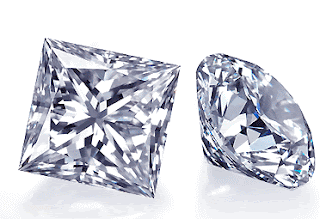The Diamond
Diamonds are beautiful, mysterious and rare. They survive an incredible journey to reach us, a journey that may have begun as long as 3.3 billion years ago. They are created when carbon is put under immense pressure and temperature deep within the earth—at distances of 250 miles or even greater.
Diamonds come from two types of deposits. Primary deposits generally consist of diamond-bearing "pipes" of a volcanic rock called "kimberlite." From deep in the earth these deposits were carried to the surface in molten rock, known as magma. Secondary deposits, also referred to as alluvial, were formed as a result of erosion of material from primary deposits and contain diamonds that have traveled some distance from their original source.
Even though world diamond production has tripled since 1980, diamonds remain a scarce resource. More than 12,000 kimberlite deposits have been found worldwide in the last 25 years, yet fewer than 1% have contained enough diamonds to make them economically viable. Geologists utilize many methods in diamond exploration, including satellite surveys, reconnaissance sampling and drilling in the ground. Some diamond producing countries include Botswana, Canada, Namibia, Russia, South Africa, Australia, and Tanzania.
After sorting, the diamonds are cut and polished. In ancient times, diamonds were left uncut and mounted into their settings, which gave each piece a dark, deep, mysterious look. In the 1400's diamonds started to be cut and polished.
Currently cutting and polishing take place in southern Africa, Belgium, China, India, Israel, Russia and the US, among other countries. Cutting a rough diamond takes great skill. A well-cut diamond reflects light within itself, from one facet to another, as well as through the top of the diamond, bringing out its spectral brilliance. The most popular cut is the 57 facet round brilliant.
After a stone has been cut, it is then polished and classified again, this time by its cut, color, clarity and carat weight, also known as the "Four Cs."
Cut: The art of polishing a diamond is to maximize its brilliance and fire (dispersion). A diamond that is cut too deep or too shallow will be less brilliant and ultimately, less valuable. The cut is the only factor of a polished diamond's value that is controlled by human hands.
Color: With diamonds, even the smallest variation in color can make a big difference. Colorless diamonds are the most popular, but nature has also created diamonds in all colors of the rainbow. All other 'Cs' being equal, the rarer the color, the more valuable the diamond is.
Clarity: Most diamonds contain naturally occurring inclusions, which developed while they were forming in the earth. The number, type, size, position and brightness of these inclusions can affect the clarity of a diamond, although most are too small to affect the beauty or brilliance of a stone.
Carat: As with all precious stones, the weight – and therefore the size – of a diamond is expressed in carats. One carat (equivalent to 0.2 grams) can be divided into 100 'points'.


Comments
Post a Comment